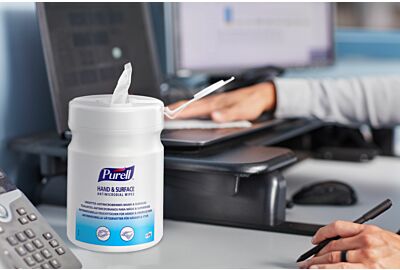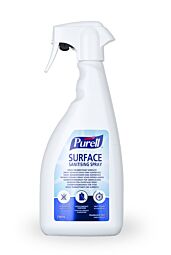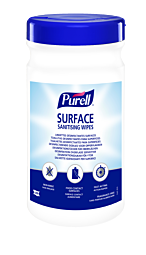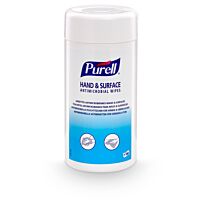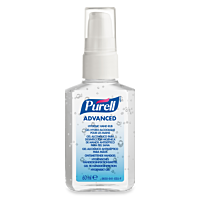Author Dawn Yeomans, Ph.D. - Research Principal, GOJO Industries
Adapted by Romina Peralta
With the potential of an early start to this year's flu season, it's time to act now to keep your businesses and workplaces healthy this flu and winter respiratory virus season. Places like retail shops, office and medical buildings, school campuses, restaurants, grocery stores, and leisure facilities, with their shared spaces and many people coming and going throughout the day, are prime incubators for respiratory viruses like the flu, respiratory syncytial virus (RSV), and viruses that cause the common cold.
What impact does flu have?
A flu outbreak can significantly impact business operations. A published study estimates that 2.4 million working adults in the UK could be infected with influenza in a year, leading to 4.8 million missed days of work annually due to the flu. This results in losses of £644 million (or 0.04% of GDP) to the UK's economy, which is equivalent to approximately £272 per infected worker¹.
When is flu season?
The flu (or influenza) is a highly contagious respiratory illness that is caused by viruses – such as influenza A or B viruses – that infect the nose, throat, or even lungs. Luckily, unlike many other illnesses, flu outbreaks are typically predictable and follow a pattern. While influenza viruses spread year-round, flu outbreaks typically occur between December and February, although activity can last as late as May and can start in the early autumn – as indicated by this year's trends in the southern hemisphere.
When do RSV and other colds typically occur – and what impact do they have?
Typically, viruses that cause cold-like illnesses remain fairly mild and last a week or two, but this year, we're already seeing children severely impacted by these viruses, including respiratory syncytial virus (RSV) – and paediatric hospitals are strained. Anyone can get RSV – while it typically causes mild illness, it can be serious for infants, young children, and older adults. Typically, RSV peaks in December through March². Many viruses can cause the common cold, but most are caused by rhinoviruses. Typically, people get the common cold in the winter and spring, but it's possible to get a cold any time of year.
How does the flu and other respiratory viruses spread?
Experts believe that many respiratory viruses like the flu virus spreads through droplets in the air that result from coughing and sneezing – and even talking. These droplets can travel as far as six feet, where they land in the nose or mouth or are inhaled into the lungs of healthy people.³ The flu virus can also live on objects or surfaces, so it's possible to spread the flu by touching contaminated surfaces. If a sick person coughs into their hand and then touches a door handle, handrail, touch screen, other highly touched, shared surface, anyone who touches that same surface afterwards could become infected.
In fact, scientists have shown that both influenza A and B viruses can survive for up to 24-48 hours on hard, nonporous surfaces such as stainless steel and plastic!⁴ According to the CDC, RSV can survive for many hours on hard surfaces such as tables and crib rails. With people touching hundreds of objects per day and touching their faces up to 34 times every hour⁵ – that's more than enough opportunity to spread germs like the flu and RSV.
Respiratory viruses do not discriminate, and the flu, in particular, can have a significant health (and economic) impact on both small and large businesses. And, as you know, it's unfortunately not the only illness going around that can negatively affect your business operations and profits. Luckily, having a pandemic hygiene response plan can ensure continuity of service during outbreaks of flu and other illnesses that can be spread by contaminated surfaces – such as colds, gastrointestinal or foodborne illnesses, and even COVID-19.
How can I help prevent the spread of the flu and other respiratory viruses at my business or workplace?
According to the UK Health Security Agency, maintaining a clean environment and providing easy access to hygiene products and supplies is one easy way to help prevent the spread of illnesses like the flu in businesses.⁶ Here is a list of steps that business owners/operators, managers, and employees can take to help minimise the spread of germs in the workplace this upcoming winter germ season.
Step 1 – Review your cleaning procedures and inventory of hygiene supplies.
Ensure all maintenance staff (or any employees participating in surface hygiene) are aware and trained on day-to-day cleaning and disinfecting procedures and what to do in the event of a flu outbreak. Products should be stocked, appropriate for use, and in-date (not expired). All disinfectants are different, so the label instructions should be followed to make sure it's being used correctly to kill the influenza virus.
Step 2 – Focus on frequent disinfection on high-touch surfaces.
Surfaces that are touched by more hands are more likely to be contaminated with the influenza virus. These include handrails, doorknobs or handles, light switches, touch screens, keyboards, elevator buttons, shopping carts, countertops or tables, and chairs. Don't miss shared high-touch surfaces in places where food or drink is consumed, such as coffee or beverage stations, shared condiment displays, water coolers/fountains, trays, or refrigerators and microwaves in breakrooms and cafeterias. Encourage frequent disinfection of employees' personal items such as mobile phones and computer keyboards/mice.
Step 3 – Ensure proper product placement. Hygiene products should be placed conveniently to promote their use by more than just maintenance staff. Consider placing disinfectant sprays or wipes in areas where employees can help to keep shared (and even their own) surfaces clean between professional cleanings. Consider providing additional supplies to promote good personal hygiene, such as disposable tissues, wipes and hand sanitiser.
Step 4 – Educate staff and set hygiene expectations. A recent study showed that providing educational reminders like posters and how-to guides to staff and users of a facility led to a 95 per cent reduction of germs on surfaces.⁷ Emphasise and reinforce the importance of hygiene to all employees and what actions they can take to help prevent the spread of germs in the workplace.
Finally, illness prevention starts in the community. Preventing the spread of flu and other respiratory viruses in businesses also helps to prevent the spread of them at home and in your community – and vice versa. Practising good hygiene in the home and when you are out and about in all the places you go will also help to keep you, your family, and your community healthy this flu season.
Sources:
- Romanelli, R. J., Cabling, M. L., Marciniak-Nuqui, Z., Marjanovic, S., Morris, S., Dufresne, E., Yerushalmi, E., & Hafner, M. (2023). The societal and indirect economic burden of seasonal influenza in the United Kingdom. rand.org/about/principles.
- European Centre for Disease Prevention and Control. (2023, June 13). Infographic: Influenza in Europe, 2019-2023. Https://Www.Ecdc.Europa.Eu/.
- The Centers for Disease Control and Prevention. “How Flu Spreads.” https://www.cdc.gov/flu/about/disease/spread.htm Accessed July 5, 2022.
- Bean B, Moore BM, Sterner B, Peterson LR, Gerding DN, Balfour HH Jr. Survival of influenza viruses on environmental surfaces. J Infect Dis. 1982 Jul;146(1):47-51.
- Zhang N, Jia W, Wang P, King MF, Chan PT, Li Y. Most self-touches are with the nondominant hand. Sci Rep. 2020 Jun 26;10(1):10457.
- UK Health Security Agency. (2022, April 1). Reducing the spread of respiratory infections, including COVID-19, in the workplace. Https://Www.Gov.Uk/Guidance/Reducing-the-Spread-of-Respiratory-Infections-Including-Covid-19-in-the-Workplace.
- National Association of Collegiate Directors of Athletics. "Crucial Hygiene Practices in Athletic Facilities: For the Pandemic and Beyond." Athletics Administration. March 2021 issue.

